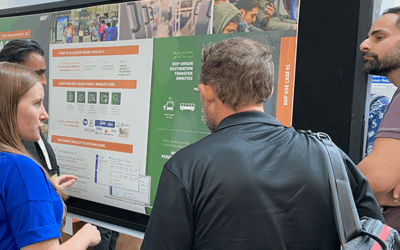Pedestrian Paradise, or Is It?

Pedestrian Paradise, or Is It?
Location. Location. Location. Tools like Walk Score® are commonly used to identify high quality pedestrian neighborhoods and cities. The higher the walkability score, the more pedestrian-friendly it claims to be, with lower scores indicating greater car dependency. A recent article by TheTravel.com ranks top California cities by their walkability scores, but do these ratings paint a complete travel picture?
Enter the metric, Vehicle Miles Traveled (VMT.) While Walk Score® describes the pedestrian environment, VMT measures how much people are driving. Walkability is great for indicating easy access to amenities and daily activities on foot, however, relying solely on these scores can overlook commute distances and quality of the transportation infrastructure. Factoring in the amount of driving, or VMT generated, can reveal how car dependent an area is on driving. Despite its traditional use by transportation experts analyzing environmental impacts, VMT is emerging as a tool with much broader applications and growing public benefit. Realtors, homebuyers, renters, tourists, and potential business owners can learn how much driving occurs within cities, communities, or more specific locations.
So Does A Walkable City Mean People Are Driving Less?
It’s easy for us to assume that a city with a high Walk Score®, denoting pedestrian-friendliness, might automatically mean it has a low VMT score, meaning people are less dependent on driving. Not necessarily. And pause to consider why that could be important. If a location had a high Walk Score® and high VMT, that would mean high walkability and people driving a lot. More people driving means more traffic congestion, road noise, parking issues, and an increased potential for collisions. Ultimately, that can begin impacting a community’s quality of life. So, how can we assess a community’s VMT score?
More people driving means more traffic congestion, road noise, parking issues, and an increased potential for collisions. These can impact pedestrian safety which can affect location desirability and quality of life.
Understanding Driving in Your Community
We’ve developed VMT+, a specialized tool crafted in response to shifting local, state, and national interests about how driving affects our communities and regions. VMT+ uses census block groups to map two important VMT metrics: home-based VMT per resident and home-based work VMT per employee. For this story, we used the home-based VMT per resident to measure and rank the VMT being generated by residents in California cities. For the Top 10 Walk Score® cities noted in the TheTravel.com article, we compared the results.
We’ve developed VMT+, a specialized tool crafted in response to shifting local, state, and national interests about how driving affects our communities and regions.
Want to Explore on Your Own?
Our California-specific VMT+ tool is open source for anyone to use and helps navigate the intricacies of CEQA. To learn more, access our tool here. If you’re interested in exploring the national data or a custom version for your state, feel free to contact us, we have plenty of data to address your goals.
Keep joining us in this series to continue learning more about other valuable and perhaps unexpected VMT applications and how you can apply this data to your projects.
² VMT is based on home-based VMT per capita
share this article
Contributors
Ron Milam
Forecasting Practice Leader
Email Me
Griffin Kantz
Engineer/Planner
Email Me
Victoria Hatch
Senior Copywriter
Email Me
Explore More
Hugh Louch Joins Fehr & Peers as a Principal
Based in our Oakland office, Hugh brings decades of experience in transportation safety and systems planning.
2025 Staff Promotions
We’re excited to recognize our team members who were promoted in 2025. Thank you for all you do!
Join Us at ITE Western 2025 | June 29-July 2
We are looking forward to joining peers across the region at the 2025 ITE Western District Annual Meeting to share ideas, practical tools, and approaches that support safer, more inclusive transportation systems.








